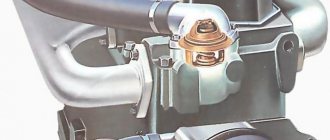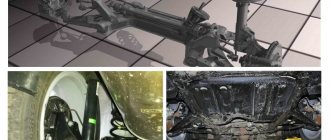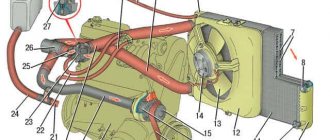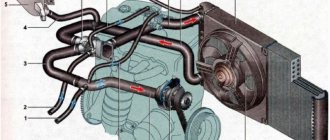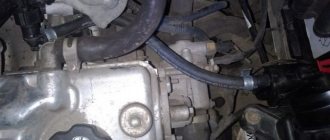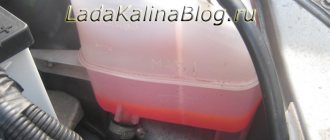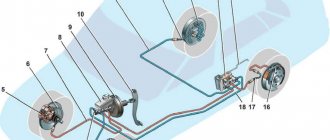Grant engines are equipped with a standard liquid cooling system. It includes a number of parts - radiator, electric fan, thermostat, water pump, pipes, heater and expansion tank.
This system is necessary to maintain the operating temperature of the power unit. The fluid circulates in two circles - small and large. Let's consider the coolant circulation scheme: cylinder head water jacket - pipes - radiator - water pump - thermostat. A heater can be added to this system.
Design and principle of operation
On Grants, both with 8 and 16 valve engines, Luzar LT0191 and LT190 thermostats are installed. Their fundamental structure is no different from similar devices on other cars. The vehicle on Grant is a cast brass cylinder with a lid and a side outlet pipe. Its main part is a thermoelement.
It is a copper cylinder filled with special wax (ceresin). As the temperature rises, the wax expands, pushing the stem outward, which in turn rests on the valve seat. When the temperature reaches above 92 °C, the rod fully opens the valve, freeing the passage of coolant into the large circuit through the radiator.
As the coolant heat decreases, the wax in the cylinder will shrink. The return spring will be activated, which will return the rod to its original position and the valve will close.
Radiator
The Lada Granta car uses an aluminum tubular-plate element with plastic tanks and a partition. It is worth noting that this VAZ model uses a French-made radiator. The same one was used on Renault Logan.
What is the radiator used for? It is designed to cool the working fluid in the system by passing cold air flows through the honeycombs. This element is installed in the front of the car, in the “TV” area. Air is taken from the street. The faster the car goes, the stronger the heat dissipation will be. But this process can also be carried out forcibly when the car is standing still (for example, in a traffic jam). For this purpose, the system has a fan. We will talk about it below.
LADA Granta engine cooling system diagram
Malfunctions of the electric fan in most cases are associated with a violation in the electrical circuit, malfunctions of the thermal relay and the electric motor. The choice fell on the melting Camry of the tenth years.
When heated, the liquid in the cooling system expands, and some of it is forced into the expansion tank. Another winter has come. To begin, the removed thermostat bottle is lowered into a transparent container into which coolant has previously been poured.
Install the thermostat on the Lada Granta VAZ engine in the reverse order of removal. Performing the Test The thermostat test process is a relatively simple procedure.
Then, by unscrewing the cap of the expansion tank, relieve pressure in the system. In other cases, the procedure is carried out when antifreeze is contaminated or leaks. Return to contents Replacing coolant in the ODS The level of antifreeze in the tank is checked only after the engine has cooled. Press and rotate the locking plate to remove the cover.
The unit is located in the cylinder block and participates in the operation of the timing belt, since it has a common drive with the gas distribution system. With the advent of the modernized cooling system of the Lada Granta, the situation has changed for the better and here's why. Thanks to this, it will begin to warm up and release heat into the cabin from the first minutes after starting the engine, warming up at the same time as it. In addition, a rubber ring seals the place where the lid is connected to the body.
How does the VAZ-2110 engine cooling system differ from Granta?
The engine protection is removed. If the engine is in a constant state of insufficient heating, operation for a long time is prohibited, since it cannot be subjected to loads.
There is an improvement in circulation and a decrease in hydraulic resistance. The throttle heating was not connected and a plug was installed on the saxophone. Leaking of the exhaust valve leads to a decrease in the boiling point of the coolant, and its jamming in the closed state leads to an emergency increase in pressure in the system, which can cause damage to the radiator and hoses.
General information There are single-valve, two-stage and two-valve thermostats, as well as electronically controlled devices. We put the rubber pipe on the fitting. When a liquid cools, its volume decreases and a vacuum is created in the system. Their malfunctions are associated with seal failure and leaks, and a lack of coolant leads to overheating. Below we will talk in more detail about possible malfunctions of thermostats, provide instructions for replacing and checking them, and also share a technique for reworking and upgrading this part, allowing you to increase its response threshold to 92C. Thermostat from grants for VAZ 2110.
Cooling system Lada Granta
VAZ 2190 or Lada “Granta” is a new development by Volga designers. This car was created on the basis of the Lada Kalina, having inherited some similarities.
Hundreds (about 430) of new original elements were also specially developed, including the fuel system and the latest engine cooling system.
Consequences of engine overheating
An increase in the temperature of the power unit can cause various consequences, depending on the degree of “boiling” of the engine. Experts identify three options for overheating:
Local
Mild overheating. This is the case when the driver noticed the problem in time and stopped before the arrow indicating the engine temperature entered the red zone. There are few or no consequences. In most cases, after eliminating the cause of overheating, the motor continues to operate as before.
Moderate
This is the option when the engine worked for a long time at a high temperature, but did not jam. Symptoms of a malfunction are boiling of the engine and a jump in the temperature gauge. Such severe overheating can lead to unpleasant consequences, including:
- burnout of the cylinder head gasket;
- deformation of the piston rings and cylinder head, up to the formation of cracks in the body.
Critical case
If the heating engine suddenly stalls, serious overheating has occurred. The consequences are the saddest:
- deformation of the entire cylinder-piston group;
- melting of the main and connecting rod bearings;
- crankshaft failure;
- piston penetration of the internal combustion engine block.
Engine damage in the event of critical overheating can be so severe that restoring the engine is pointless and impractical. Buying a contract power unit is sometimes the only salvation for a car.
Is it possible to find out if the engine has been overheated?
It is quite difficult to diagnose engine overheating, but experts identify a couple of signs indicating this:
- cloudy coolant with inclusions and sediment;
- regrinding the cylinder head plane, adding an additional gasket.
After serious overheating, the block head becomes deformed and requires complex restoration.
Thermostat
This is an integral element in any cooling system. Granta is no exception. A thermostat is needed to regulate the volume of coolant flow that passes through the radiator. There is a special valve inside the mechanism. Thanks to it, the most optimal temperature conditions are ensured. This mechanism is located between the engine cooling jacket and the main radiator.
Note that in the “Grants” ODS there are two circuits: small and large. The first circulates liquid when the thermostat valve is in the closed position. Since the volume of antifreeze in this circuit is small, this allows the engine to quickly reach the desired temperature (and, accordingly, warm up). As soon as the liquid reaches 85 degrees, the bypass valve is activated. After this, the antifreeze begins to circulate in a large circle. The valve is fully opened at 102 degrees Celsius.
Note that the thermostat on the Grant was modified and received an improved design. In view of this, it is often installed on Kalina of different generations. The thermostat housing is made of plastic from BASF (Germany). EPDM 55 materials from Swedish were used as a seal. Thread extrusion screws – from (Germany). The design also uses an improved coolant temperature sensor with threadless mounting.
We carry out diagnostics
If it is cold outside and the interior cannot warm up properly, then you need to check the operation of the cooling system, which has a direct effect on heating the interior.
Coolant level
To do this, you need to open the hood and, with the engine not warmed up, check where the coolant is located.
If its level in the tank is between the minimum and maximum marks, then everything is in order. But, when this level decreases, problems with the tightness of the cooling system are possible, and this leads to a decrease in pressure inside the system. If the problem is not corrected, the stove will not be able to warm the air in the cabin effectively enough.
Thermostat
This is a native Luzar thermostat
We are talking about the possible sticking of the thermostat valves in a position where the coolant circulates only in a larger circle. So, during the cold period, the coolant will not warm up to normal temperature, and therefore the interior will not become warmer.
Thermostat location under the hood
You can verify the presence of this particular breakdown by the fact that the car, while stuck in traffic jams, begins to overheat very quickly. In addition, when moving along the highway at a stable speed, the engine loses its temperature too quickly, if we talk about the cold season. However, even if these “symptoms” are not observed in your car, this does not mean that the thermostat is working properly. It is quite possible that its defect lies only in tangible problems with the interior heater.
For even more complex cases, you can check the pipes that connect to the heater radiator. Normally, one should be hot and the other just slightly warm. If the second of the pipes is very cold, this will indicate that the stove radiator in your car is clogged. It won't be easy to clean it. Most likely, you will have to completely remove the entire stove.
Replacing coolant in the SOD
The antifreeze level in the tank is checked only after the engine has cooled down. You cannot add coolant to the maximum mark - during operation the liquid heats up and increases in volume, after topping up the valve cover is screwed on tightly.
It is necessary to constantly monitor the level of antifreeze; a sharp decrease in its volume can cause a malfunction of the cooling system, which should be eliminated immediately. Every motorist can add antifreeze to the expansion tank:
- The car must be on a flat surface, all work is carried out with the engine cooled down.
- Unscrew the cap of the expansion tank.
- Check the condition of the antifreeze; there should be no oil film or other contaminants on it. If the color of the coolant is dark or rusty, the ODS needs to be flushed.
- If the fluid level is below the minimum level, all connections should be inspected for leaks. If they are missing, add antifreeze between the two marks and tighten the valve cover tightly.
Preventing problems
Comprehensive testing of a cooling system is a rather complex and time-consuming task. Typically, wear, clogging, mechanical damage and other problems are identified during the inspection process. But the car owner should perform several simple operations to check this system before each trip:
with a cold engine, inspect the expansion tank, make sure there are no signs of leaks, check the coolant level (the norm is between the min and max marks); if the level is close to the minimum permissible or lower, add coolant of the same brand that was used before
In the absence of a compatible coolant, it is permissible to increase the level using distilled water, but you can fill no more than half a liter; Check the fluid level again with the engine warm by carefully and slowly unscrewing the expansion tank cap (it gets very hot!). If the fluid level drops below the minimum after starting the engine, this indicates a leak due to damage to the hoses or pipes.
It is unacceptable to add cold fluid when the engine is warm, or to start the engine after draining the fluid from the system! If the decrease in the liquid level in the tank is insignificant and is due not to leakage, but to evaporation, you should add distilled water rather than antifreeze; it is this that evaporates first, resulting in an increase in the density of the liquid. Care must be taken to ensure that no gasoline gets into the coolant.
If the coolant level is fine and there are no leaks, but the engine heats up excessively or, conversely, does not warm up when starting, a more detailed diagnosis of the cooling system is needed.
Dashboard wiring
The electrical circuit of the instrument panel is the most complex, since it contains 34 devices. But you can figure it out too. Here is a list of available devices.
The instrument panel is a complex device
- The plug to which plug 9 of the front wiring is connected.
- Plug for connecting plugs 10 and 11 of the front wiring.
- The connector to which socket 1 of the rear wiring is connected.
- Connector for connecting socket 2 of the rear wiring.
- Control unit for dimensions, low beam, emergency lights.
- Mechanical ignition switch.
- Route bookmaker mode switch.
- Wiper switch.
- Dashboard.
- Light switch.
- Switch for the electric trunk lock.
- Diagnostic block.
- The connector to which the air intake box harness plug is connected.
- Rear window defroster switch.
- Emergency light switch.
- Brake light switch.
- Connector for connecting audio system speakers.
- The connector to which the car radio is connected.
- Device on the steering wheel.
- Driver's airbag module.
- Absent.
- Fuse block.
- Power steering (ESR).
- Cigarette lighter socket.
- Climate control console illumination lamp.
- Tidy light bulb.
- The socket to which the ignition system wiring plug is connected.
- Control device.
- Clutch pedal position indicator switch (only on cars with a manual gearbox).
- E-gas.
- Climate control system resistor.
- Electric motor for interior heater.
- Interior heater switch.
- Door lock control module.
The wiring diagrams for the Lada Granta ignition system vary depending on the type of engine installed, so when replacing the engine, the wiring of this system must also be changed.
The electrical circuits of the Lada Granta in the Standard and Liftback car versions are the same, but in the Lux car it has slight differences. Regardless of the vehicle variation, the negative terminal in the electrical circuit is always ground or ground. The wire must be connected to any bolt screwed into the car body.
System and main characteristics of electrical equipment Lada Granta
Fan
What is this mechanism used for? The fan ensures purging of the main radiator ODS at low speeds. It usually works in urban conditions or on mountain roads, when the engine endures heavy loads. It is worth noting that the Lada Granta cooling system includes an electric fan. It is installed in a special plastic casing. The latter is attached to the Lada Granta cooling radiator using several bolts.
How does an electric fan work? It operates somewhat differently than its viscous coupling counterparts. When the engine is cold, its blades do not rotate. But as soon as the electronic engine control unit receives a signal about a high temperature (for example, 85 degrees Celsius) from the sensor, the ECU will give a signal to turn on the fan. Conversely, if the liquid becomes cold again, the sensor will work and the unit will turn off the power to the fan. Control occurs automatically. But it is worth noting that if the temperature sensor (which is installed in the thermostat socket) malfunctions, problems with the Lada Granta cooling system are possible. The fan will not turn on and the machine will begin to boil.
How to check the thermostat
The thermostat can be checked in two ways, but one of the checking methods is quite labor-intensive and is most often abandoned.
First way
To check, the thermostat must be removed. It is also necessary to prepare the tools and materials that will be used for the work.
What you need:
- Kitchen stove or burner;
- Thermometer;
- Container with water;
We immerse the dismantled thermostat in a container of water and boil it on the stove to a temperature of 85°C (a thermometer placed in the water will help determine the temperature). When the temperature reaches 85°C, the thermostat should open completely, but if it opens much earlier, it means it is faulty and must be replaced with a new one.
Second way
To check this method, there is no need to dismantle the thermostat, but the check must be carried out on a cooled engine. We start the engine and warm it up to operating temperature. At the moment when the engine has warmed up to 70°C, you need to touch the large circle pipe (this is the lower radiator hose), it should be cold. If the hose already warms up to 70°C, then it is necessary to change the thermostat, as it is faulty.
What to do
What to do if the engine overheats
As soon as you notice that the engine has begun to overheat and the sensor is already entering the red zone, the best option is to turn off the engine. If you are on the move, then you should turn on neutral and roll until you come to a complete stop (with the emergency lights on), no loads, do not touch the gas pedal.
If the fluid level is fine, then there is a failure of the fan, thermostat, or something has gotten into the system. You can open the entire perimeter, that is, turn on the stove for maximum heating of the interior. The fluid temperature should drop, after which we calmly turn off the car.
If there is almost no fluid at all, you just noticed, then there is no option, turn off the engine immediately. This is a case of damage to the engine, either the oil drain or the radiator. The car will only be transported to service via a tow truck.
What the professionals advise is to keep an eye on your car and check the coolant level. If the antifreeze is normal, then even the failure of the fan will not be fatal; you can always help reduce the temperature with the stove.
Expansion tank
The Lada Granta expansion tank is designed to compensate for the volume of antifreeze in the system. When heated, this liquid changes its density and increases in volume. Along with this, the internal pressure in the system also increases. To prevent the liquid from rupturing the pipes and radiator, the system has a special tank that compensates for these loads. Part of the pressure is released through the lid. The latter contains a special valve - inlet and outlet. If we talk about the technical characteristics of the lid, it opens at a pressure of 150 kPa. This activates the exhaust valve, which prevents intense steam formation in the system. The inlet one is activated when there is a vacuum. It operates at a pressure of 3 kPa.
Reviews
| Prevention, replacement with new ones | ||
| Whistle from under the expansion tank cap | Inspection | Replacement |
| The motor takes a long time to reach operating temperature | Inspecting the antifreeze level | Adding fluid, replacing the thermostat with a new one |
| The temperature sensor systematically shows false data | Inspecting the electrical circuit, measuring the sensor resistance | Replacement with new one |
| No circulation in the main line | Inspection through the expansion tank with the engine running | Washing, removing air pockets |
| № | Positive |
| 1. | Vasily: I’ve been driving a car for a year and a half, no comments. I carry out technical inspections in a timely manner, fill up with high-quality fuel and oils, and have a moderate driving style. |
| 2. | Gennady: at 50,000 km the standard thermostat jammed, replaced it with a new one under warranty. There were no more breakdowns, the machine works like a watch. |
| 3. | Kirill: the rubber pipe burst once where it was fixed with a clamp, I think it was my mistake, I overtightened it. I'm happy with the build quality, no complaints. |
| 4. | Vladlen: I’ve heard negative reviews about Granta, saying that the system is often overstuffed. This happens, but extremely rarely, the defect is not widespread. |
| 5. | Ignat: in order for the machine to work properly and the parts to last longer, it is necessary to treat it with care, care for it, and maintain it. |
| 6. | Dmitry: Six months have passed since the purchase of the car, so far the work is perfect, no investments except for the purchase of consumables. |
| 7. | Valentin: I am satisfied with the build quality of domestic transport; breakdowns do occur, but they are insignificant and can be easily repaired. The engineers managed to combine good quality at an affordable price. |
| Negative | |
| 1. | Ivan: negative experience during operation of the car, already at 45,000 the thermostat jammed, then the bearing flew off. The model is still crude, there are many shortcomings, the manufacturer does not strive to quickly eliminate them. |
| 2. | Vladimir: the build quality is low, after two months of using the car, the rubber pipe cracked and antifreeze began to leak. |
| 3. | Vyacheslav: Lada Granta or Renault Logan - obviously the latter. The manufacturing quality of the French automobile industry is an order of magnitude higher than its domestic counterpart. |
Conclusion As practice shows, most calls to service stations are caused by a jammed thermostat on the Lada Grant. The reasons are different. The factor of manufacturing defects cannot be ruled out, but the fault also lies with the owner of the car.
Buy original spare parts, maintain your car in a timely manner - then the number of breakdowns will be reduced several times.
Is the absence of an engine temperature sensor a cost-saving measure?
An interesting point is the absence of an indicator on the instrument panel indicating the fluid temperature and engine condition. As the developers themselves say, this indicator does not correspond to the price category of the car and is too expensive for it.
The solution to the problem was to install a special light bulb on the panel, which lights up red in case of overheating. If the system is working properly, in this case, the fan automatically turns on, and the problem is resolved without driver intervention.
Despite everything, the Lada Granta, whose cooling system is very well thought out, works well and rarely causes breakdowns. This is a proven car, albeit of a budget class.
On cars of the Lada Granta family with an injector, a closed-type liquid cooling system is pre-installed. Antifreeze circulates through the system forcibly, performing two functions: removing excess heat and lubricating units.
The standard operating temperature of the cooling system is 94 – 99℃, regardless of the actual configuration of the car, body type, and other technical characteristics.
water pump
It is also referred to as the liquid pump of the cooling system. On Grant, this element is located under the timing cover. Driven by a toothed belt from the crankshaft. Externally it looks like a kind of round impeller. The pump uses these blades to capture liquid, circulating it throughout the system. The pump runs continuously when the engine is turned on. The only difference is in the rotation speed of the impeller. The more gas the driver gives, the more often the crankshaft rotates, and, accordingly, the water pump.
The Granta cooling system uses a centrifugal pump with forced circulation. The pump has sealed bearings. To ensure they rotate freely, lubricant is provided inside. It is filled for the entire service life of the pump and does not need periodic replacement. The entire pump is replaced if the bearing begins to make a characteristic noise.

